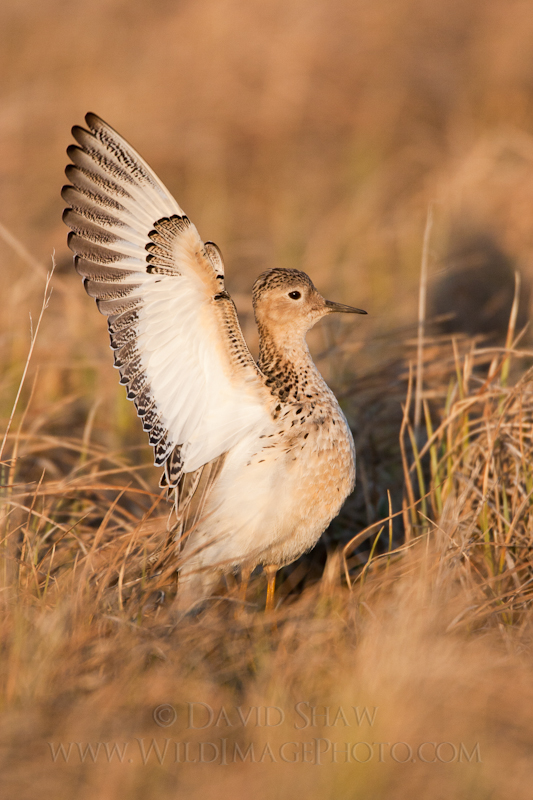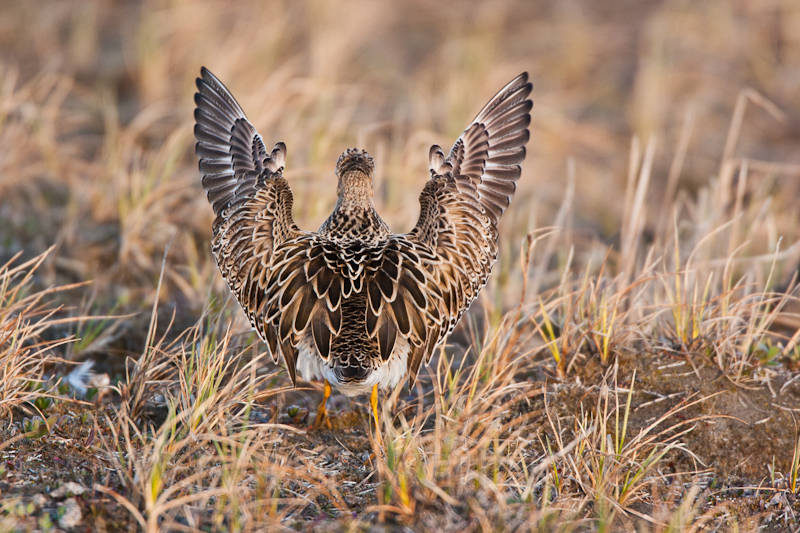Staying within the Arctic National Wildlife Refuge, today I’m sharing three images of Buff-breasted Sandpipers made in the middle of the night (still sunny that far north) on the Canning River Delta in June of 2007. Buff-breasted Sandpipers were one of the target species of that particular trip and we’d spent many hours wandering across the wet tundra in search of displaying birds. Buffs have incredible breeding displays where they rase and shake their wings, put one wing up in the air, showing off the elegant plumage beneath and wave it slowly around. It a beautiful thing to watch on the tundra of the coastal plain. Bizarrely, after days of searching without success, three birds turned up within ten yards of our tents. Two males and a female. For two or three hours we photographed the birds as the males competed for the attention of the female. They were incredibly tame, at times walking within touching distance, just to throw their wings up in a display too close for the camera to focus.
The three images here all share one particular feature: each are “almost” images. They are almost what they could have been, but for their own reasons falls a bit short.
The top image shows a bird nicely posing atop a small rise in the tundra. This creates a lovely separation between the bird and the background. The background is nicely blurred and the sandpiper stands out nicely from it. The late-night Arctic light is lovely and soft, and the colors of the Buff-breasted and the surrounding tundra match almost perfectly. Compositionally, its flawed. I put the bird in the dead center of the frame. It would look more balanced had I shifted the bird to the right a bit allowing the beak to point into the frame. The final, and what I think is perhaps the biggest (and not digitally repairable flaw) is the focus. The auto-focus on the camera grabbed the feathers of the bird’s back not the eye. At the time, I even recall thinking that was OK, because I assumed the depth of field would include the face. It didn’t. I was still learning about my new 500mm f4, and didn’t yet realize just how narrow the depth of field is on that lens. Wide open, it’s about 2 inches, not near enough to encompass the whole bird. Despite the flaws, I’ve held onto the image, and its been published at least once, so apparently they aren’t fatal issues.
The second image shows a displaying male from the back. Despite its flaws, which I will get to in a minute, I like this shot a lot. I love the pose, and the beautiful repetitive pattern of the plumage of the bird’s back. The wings point up in nearly perfect symmetry and create a great visual balance. But there are at least two issues, the first I had no control over, the second, I did. First is the bird’s pose, it’s great, but how I wish it had raised its head in the more typical spread-wing posture. If it had, the beak would have come into view and possibly the eye, both of which would have added some more visual interest to the image. And the final point, is I really wish I had gotten a lower perspective. As I recall I was sitting when I made this image, the camera mounted on its tripod about two or two and a half feet above the ground. If I’d gotten even lower, laid down on the tundra, I could have gotten some nicely blurred foreground elements and done an even better job of separating the bird from the surrounding tundra.
 This final image shows the wing-waving display of a male Buff-breasted Sandpiper. I love the light in this image, and the nicely blurred foreground and background. The underwing, with its heart-wrenchingly beautiful plumage is well exposed with no blown-out highlights and is tack sharp. Unfortunately that last point is also the image’s major flaw. I focused on the wing, not the face, again hoping that the depth of field would incorporate the face, and again it didn’t. This is an interesting point about photography, the feature that makes this image most interesting, the raised wing, should not have been the point of focus, it should have been the eye. The eye should always, always, always be the point of focus of a wildlife image. Humans are visual animals and our eyes are immediately drawn to the eye of the subject, and in this case, I missed it. Damn.
This final image shows the wing-waving display of a male Buff-breasted Sandpiper. I love the light in this image, and the nicely blurred foreground and background. The underwing, with its heart-wrenchingly beautiful plumage is well exposed with no blown-out highlights and is tack sharp. Unfortunately that last point is also the image’s major flaw. I focused on the wing, not the face, again hoping that the depth of field would incorporate the face, and again it didn’t. This is an interesting point about photography, the feature that makes this image most interesting, the raised wing, should not have been the point of focus, it should have been the eye. The eye should always, always, always be the point of focus of a wildlife image. Humans are visual animals and our eyes are immediately drawn to the eye of the subject, and in this case, I missed it. Damn.
Despite the flaws if you’d like to buy prints or digital downloads of these images you can find them and other shots of Buff-breasted Sandpipers here on my stock site.
Related posts:
A photo essay of mine on the bears of Katmai National Park was just pub...
Spot-backed Puffbird, Canon 5D III, Canon 500mm f4L IS w/ 1.4x TC, f5.6, ...
A couple of days ago we conducted a landing at Isla Guanape off the coa...

